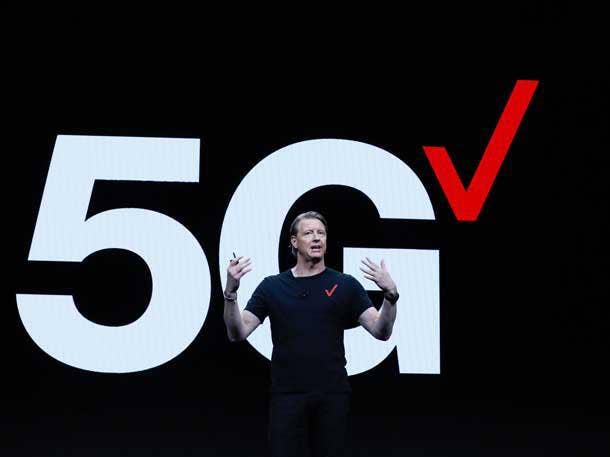'Verizon 2.0' Restructure Is Paying Off, CEO Says
Recently revamped on the operations side, Verizon's strength in wireless and fiber, coupled with its aggressive 5G efforts, led to a successful Q2, according to Verizon CEO Hans Vestburg.

Verizon's new operating structure, wireless success and leadership in 5G is paving the way for revenue growth, Verizon CEO Hans Vestburg told investors on Thursday.
The telecom giant last fall hit the reset button, refocusing itself around network transformation, fiber, and 5G. At the same time, the Basking Ridge, N.J.-based carrier restructured its customer-facing units in an effort that Vestburg calls "Verizon 2.0," which contributed to Verizon's positive financial results during Q2 2019, he said.
"We're making this transformation from a position of strength. It really sets us up to continue to be a leader in this market," Vestburg said during the carrier's second-quarter earnings call.
[Related: Verizon IoT Network Launched Across U.S.]
Verizon began extending early-retirement buyout deals to thousands of its employees in 2018 as part of its company-wide restructure. The carrier saw the final group of employees that took the carrier up on the offer leave its balance sheet in June and so far, the company has realized about $480 million in savings, according to Matt Ellis, Verizon's executive vice president and CFO.
Verizon said the deal, which was extended to all management employees, would help trim its costs by about $10 billion by 2021 and the company is on-track to hit that target, Ellis said.
But business isn't growing solely due to fewer salaries. Verizon's strength in wireless helped anchor the carrier's strong earnings during the second quarter.
Overall, wireless operating revenue across both consumer and business rose slightly to $22.68 billion during the second quarter, compared to $22.45 billion in second-quarter 2018. Verizon saw a jump in cell phone subscribers, with 325,000 retail postpaid net additions specific to its business segment, including 172,000 phone net additions. In the consumer segment, Verizon had 126,000 retail postpaid net additions, including 73,000 phone net additions and 209,000 postpaid smartphone net additions.
Another area that Verizon will be leaning on for growth is 5G. The carrier recently won more millimeter wave spectrum, which Vestburg said will give Verizon the portfolio it needs to build more capacity and converge in the era of 5G.
Verizon in April kicked off the rollout of its 5G ultra wideband internet by turning on the service in parts of two cities; Chicago and Minneapolis. The carrier has since turned on 5G in Providence, R.I. and St. Paul, Minnesota. Verizon on Wednesday also revealed that consumers in Atlanta, Detroit, Indianapolis and Washington, D.C., can now access the network and it said it will make the service available in more than 30 cities by the end of this year.
"We've been saying all the time that we're going to build real 5G," Vestburg said. "We're on track to build the 30 markets that we've said will build this year, [and] at the same time, we continue to add new devices to the portfolio … we now have four different devices on 5G."
Verizon also remains focused on fiber, Vestburg said. The fiber footprint is now in more than 60 cities, and the company added 1,004 route miles on average each month during the second quarter, he said. "This build is so important for an intelligent edge network and for the 5G build we're doing," Vestburg stressed.
As part of its Verizon 2.0 effort, the carrier restructured its Wireline Division, which is now called Verizon Business on its balance sheet. Verizon Business includes its Global Enterprise Solutions, small and midsized business, public sector, and wholesale. The segment slipped slightly overall by 1.1 percent to $7.77 billion during second-quarter 2019 from $7.85 billion in the year-ago period, which the carrier attributed to growth in wireless and fiber products being offset by ongoing secular pressures from legacy technologies.
Specifically, Global Enterprise revenues declined about 4.9 percent to $2.67 billion in revenue, compared to $2.81 billion in the second quarter of 2018. SMB revenue grew 5.4 percent to $2.79 billion during Q2 2019, up from $2.64 billion in the year-ago period. Public Sector increased 3.4 percent to $1.49 billion during the quarter, up from last year's Q2 result of $1.44 billion. Wholesale revenues, on the other hand, took a hit during the quarter, slipping by 15 percent from $818 million, down from $964 million in Q2 2018.
Despite the decline in enterprise revenues during the quarter, Vestburg said Verizon is getting more traction with these customers thanks to better support and its solutions-focused go-to-market approach with this group.
Overall, Verizon reported stronger than expected financial results for the second quarter, which ended June 30, 2019. The carrier had operating revenue of $32.07 billion in the quarter, down about percent from $32.30 billion in the second quarter of 2018. Verizon's net income for the quarter was $4.07 billion, down slightly from $4.25 billion during the same period last year. The carrier reported adjusted earnings per share of $1.23 cents, up 2.5 percent compared to adjusted earnings per share of $1.20 during second-quarter 2018. That topped Wall Street's expectations of $1.20 earnings per share in revenue.